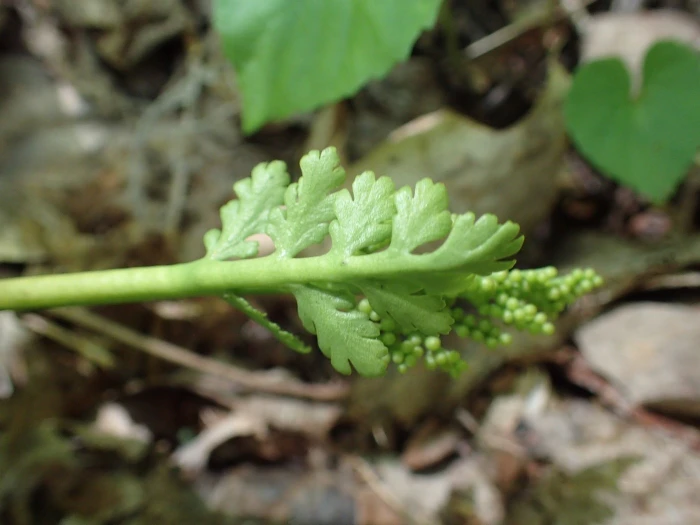Chamomile Grape-Fern
(Botrychium matricariifolium)
Chamomile Grape-Fern (Botrychium matricariifolium)
/
/

© Evan M. Raskin
CC BY 4.0
Image By:
© Evan M. Raskin
Recorded By:
Copyright:
CC BY 4.0
Copyright Notice:
Photo by: © Evan M. Raskin | License Type: CC BY 4.0 | License URL: http://creativecommons.org/licenses/by/4.0/ | Uploader: eraskin | Publisher: iNaturalist |

























Estimated Native Range
Climate Requirements for Sandusky, Ohio
| This Plant | Your Site | Plant Suitability for Your Location | ||
|---|---|---|---|---|
| • Precipitation | 16" - 102" | 35" | Your precipitation may be insufficient for this plant. Irrigate N" / year. | Irrigate N" / year |
| • High Temp. | 50°F - 88°F | 83°F | Your summer temperatures are normal for this plant. | Excellent |
| • Low Temp. | -21°F - 39°F | 18°F | Your winter temperatures are normal for this plant | Excellent |
This plant should grow well at your location with about N inches per year (Y minutes per month) of irrigation.
Summary
Botrychium matricariifolium, commonly known as Chamomile Grape-fern, Daisyleaf Grape-fern, or Matricary Grape-fern, is a perennial herbaceous fern native to temperate deciduous forests, often found in moist, shaded areas with well-drained, loamy soils. Its range extends across Europe and into parts of eastern North America, including Canada and the United States. It typically grows up to 12 inches tall, featuring dull green, highly dissected sterile leaf blades and longer fertile leaves that bear spores. The plant has a unique appearance with its grape-like clusters of spores, which are held aloft on erect stalks, distinguishing it from other fern species.
Chamomile Grape-fern is valued for its rarity and unique foliage, making it an interesting addition to shade gardens or native plant collections. It requires minimal maintenance once established in a suitable location, mimicking its natural habitat. In cultivation, it prefers partial to full shade, consistent moisture without waterlogging, and rich, organic soil. Due to its rarity, it is not commonly used in large-scale plantings but may be found in botanical gardens or specialized native plant nurseries.CC BY-SA 4.0
Chamomile Grape-fern is valued for its rarity and unique foliage, making it an interesting addition to shade gardens or native plant collections. It requires minimal maintenance once established in a suitable location, mimicking its natural habitat. In cultivation, it prefers partial to full shade, consistent moisture without waterlogging, and rich, organic soil. Due to its rarity, it is not commonly used in large-scale plantings but may be found in botanical gardens or specialized native plant nurseries.CC BY-SA 4.0
Plant Description
- Plant Type: Fern
- Height: 0.1-0.3 feet
- Width: 0.5-1 feet
- Growth Rate: Slow
- Flower Color: N/A
- Flowering Season: Non-Flowering
- Leaf Retention: Deciduous
Growth Requirements
- Sun: Part Shade, Full Shade
- Water: Medium
- Drainage: Medium
Common Uses
Border Plant, Low Maintenance
Natural Habitat
Temperate deciduous forests and moist, shaded areas with well-drained, loamy soils
Other Names
Common Names: Daisy-leaved Moonwort, Daisy-Leaf Grape Fern, Daisy-Leaf Moonwort, Matricary Grapefern
Scientific Names: Botrychium matricariifolium, Botrychium lanceolatum, Botrychium lunaria subsp. matricariifolium, Botrychium lunaria var. matricariifolium, Botrychium lunaria var. matricariifolium, Botrychium lunaria var. rutaceum, Botrychium matricariifolium, Botrychium matricariifolium f. gracile, Botrychium matricariifolium f. rhombeum (×ngstr.)
GBIF Accepted Name: Botrychium matricariifolium